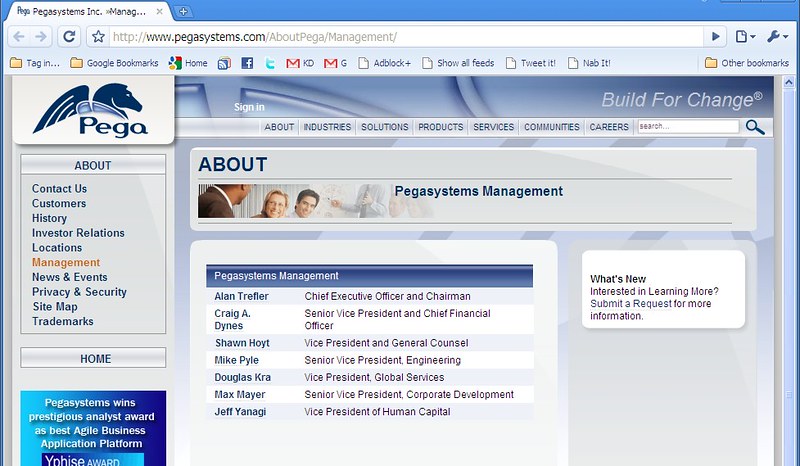I had a heads up this morning via Shane Schick’s Twitter stream that Gartner was holding a webinar on emergency cost cutting in IT, featuring Kurt Potter, and 20 minutes later I was there.
Gartner’s been talking with a lot of their customers about the impact of the recession, and although most are not in completely dire straits, they are seeing some who are having to deploy emergency measures, and there’s lessons to be learned from the squeezing that is being done.
There are factors in any organization that make it difficult to cut costs:
- Too much customization and complexity: I see this a lot, and it’s a huge money drain to maintain overly complex and over-engineered systems. If you go for a fully customized system, it’s going to cost about 10x as much to maintain it over the long term as it was to build it in the first place, since you’re rewriting code for every minor change.
- Costs weren’t aligned to business metrics, so money has been spent on something that may not have had an economic benefit.
- Difficult to prioritize IT investments properly, so that companies don’t know what to cut first.
- No institutional knowledge of what happened in the last recession.
An economic recession creates some particular leadership challenges, but also opportunities: it’s a chance to make some difficult changes and cuts that would never be allowed in fatter times for political reasons. In particular, when a project (like a BPM implementation) calculates its ROI through a reduction in headcount, those staff are rarely actually cut: they’re redeployed to other areas, or the group affected just runs a bit heavier that it needs to. In today’s climate, you should be going back to see if you can harvest those promised productivity improvements now.
It’s difficult for companies to cut costs if they’ve never had to do it before: it’s not in their culture, and the executives may have made rash statements about things that they will “never” do, such as laying off staff or cutting out perqs. Surviving in this environment, however, requires some change in culture, and that includes changes to IT culture. Has your IT organization said that they would never use open source, or outsource storage, or consider SaaS? If you’re in a pinch, then you can be sure that they’re looking at it now, at least for some functions; if they’re not even considering options like this, then they’re not that serious about cutting costs.
Potter came out with one pretty obvious slide that showed that companies that have spent proportionately more on IT in the past five years have more room to cut costs. Well, duh. It’s hardly a big surprise that those that have spent like drunken sailors on leave now have a lot more that can be cut, like selling off that corporate jet (Citigroup, are you listening?). For some, however, cutting costs further gets a bit closer to the bone, requiring business restructuring, process improvement and innovation: this is why BPM projects (but not necessarily additional license acquisitions) can get some additional interest at times like this.
There are some cost-cutting measures that Potter suggested that I really don’t agree with, since I think that they’re penny-wise and pound-foolish. First of all, cancelling all IT training. Although this may result in a higher level of voluntary turnover (as much as 40-60%), thereby reducing headcount without having to do pesky, lawsuit-provoking layoffs, it runs the risk of having the people who understand the current systems bail out, leaving behind no one who is trained to maintain them. Personally, I wouldn’t want an untrained DBA playing around with my production database: the combined cost of a longer time to get things done plus the time required for someone who knows what they’re doing to fix it later is likely to be much higher than any training course.
Secondly, he suggests that IT abandon SLA guarantees to the business, become reactive rather than proactive, and train IT staff to say “no” to the business unless the funding for that level of service is guaranteed. In my opinion, this would be a huge hint to the business to start looking at outsourcing some of that IT, particularly through the adoption of SaaS applications. Lots of money being spent on running your in-house Exchange servers, and now IT wants to cut your SLA? A recent Forrester report shows that cloud-based email is a no-brainer over hosting your own email servers up to 15,000 users, and the price leader (Google Apps, which allows you to host your domain email on Google) is more cost-effective far beyond that size, while providing additional tools such as collaboration sites as part of the same package. More complex applications, such as customer relationship management and even business process management, have a number of successful cloud vendors. My advice to businesses: if IT cuts your SLAs, start looking for alternatives to your current IT offerings.
Potter suggested some good areas for savings, too: lengthen replacement cycles on hardware and software, cancel maintenance and warranty contracts, consolidate data centers and storage, and just buy less stuff. There’s risks to all this austerity, too. In addition to more voluntary turnover (which may or may not be desired), your vendors will smell the blood in the water and start tightening up on credit.
Of the webinar participants, over 80% said that it would be at least Q1 2010 before they return to a growth strategy rather than cost-cutting mode, so this is here to stay for a while.
Gartner has more than 300 pieces of published research on cost optimization, although some of the ones quoted (“Communicating the Value of EA to CFOs”) are arguably not really on topic. There’s a whole section on the Gartner site on IT and the economy that includes previously recorded podcasts, upcoming webinars and links to related research.

